
The history of Mongolia is intricately tied to the history of migration and settlement of the Mongols. The Hun and Xianbi dynasties were founded in the territory of present-day Mongolia and were a nomadic civilization.

The most powerful era in the history of Mongolia was when Genghis Khan united the Mongol tribes and provinces to form the Mongol Empire in 1206, and conquered the countries of Asia and Europe by military force.
The successors of Genghis Khan extended their realm up until the 13th century and established sovereignty over the largest swath of land in recorded human history, extending from Vietnam to Eastern Europe. The places reached by Mongolian cavalry embrace Western Europe, the Iberian Peninsula, the Philippine Islands and Japanese Islands to the east, and the Kamchatka Peninsula to the north. A total area of more than 40,000,000 km² was under its control at that time.
The Mongols continued to lead a nomadic lifestyle despite making a significant contribution to world history and revolutionizing trade and culture between Asia and Europe. The Golden Horde, the Il-Khanstvo, the Chagaadain, and the Yuan were the four great powers that emerged from the division of Great Mongolia in 1262, and they fought or cooperated until the 16th century. At this point, Buddhism started to have an impact on the Mongols, and soon after that, from the end of the 17th to the middle of the 18th century, the majority of the Mongols were ruled by the Qing dynasty. When the Qing state fell apart in the 20th century (in 1911), the three nations, namely China, Tibet, and Mongolia all attained independence at the same time. Bogd Khant Mongolia was first founded by the Mongols in this period with assistance from Imperial Russia and in 1924, The People's Republic of Mongolia was established with assistance from the Soviet Union, becoming the second socialist state in the history of the world. Following that, it was able to develop alongside the Soviet Union. Mongolia experienced the same effects of the 1989 revolutions in Eastern Europe, and as a result, it reformed to a constitutional, free-market country with a democratic government in 1992.

Modu Chanyu

The Huns together with other countries attacked the Qin kingdom in 318 BC, and this event was first recorded in historical scriptures. In 209 BC, Modun assassinated Tumen Shanyu, his father, and took over the Shanyu throne. Shanyu, which in ancient Chinese meant "vast," is thought by scholars to be an early spelling of the Mongolian word for "good." For the first time in Central Asian history, Modun transformed the nomads' social, military, and administrative structure and built a robust army made up of groups of ten, hundred, thousand, and ten thousand soldiers.
Modun Shanyu divided his territory into three parts. The central section was governed by Modun Shanyu, and four clerks-East Setsen Wang, East Guli Wang, West Setsen Wang, and West Guli Wang serving in hierarchical ranks and collectively known as the "four horny Wangs"—were in command of the right and left halves of Modun Shanyu's empire.These four Wangs represented the largest administrative units, and they were directly selected by the Shanyu, had special palaces, owned land, and over ten thousand cavalry under their command. There were 1.5 million Huns, according to researchers.
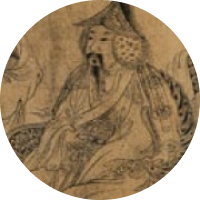
In the history of nomads, the Huns fought around 30 major wars, conquered numerous countries both close and distant, and founded the first empire.
"Land is the basis of the state," asserted Modun Shanyu, "and the existence of the state of Hunnu entails the possession of land". "The archers in the territory beyond the White Wall shall obey the Shanyu, and the Han Dynasty shall reign within the Great Wall," the pact that the Huns and the Han signed in 198 BC to establish the boundaries of their respective realms, read. On white cloth and shoddy paper, it is painted in various hues. The Han Dynasty provided grain, gold, and magnag silk (silk woven with gold and silver threads to resemble a dragon) to the Shanyu of Hun for more than 50 years.
Moreover, it occupied the majority of the Central Asian countries, had them provide it with grain and rice, imposed internal tax regulations, and carried out population and livestock censuses, all of which show that they were literate.There were items found in Ikh Dulam and Buregkhangai Sums of Bulgan Province that showed clerks had writing instruments.
The Huns' capital city, Luut, was situated in what is now the province of Arkhangai, either in the Khashaat sum region or in the valley of the Orkhon River. The Huns engaged primarily in nomadic livestock husbandry, small-scale agriculture, hunting, and craft-based subsistence. They also practiced shamanism, and in the months of May and September they sacrificed to the sky. The Shanyu worshiped the rising sun every morning and the moon every night.


Genghis Khan (1162-1227)

Genghis Khan dealt with his tribe first, then his ethnic groups, and ultimately his opponents. When reviewing the history of any king, the majority of scholars concur that "Genghis Khan's story is the greatest story of the kings, and it was a story that turned the globe upside down."
Alungua Queen, the ancestor of Mongols is the 12th generation descendent of Burt Wolf and Gua Maral while Temujin is the 10th generation descendent of Alungua Queen. Temujin was crowned "Genghis" in 1189 after ascending to the Mongol Empire. The name Genghis, which derives from the word "sea," is understood to signify that the king's power is as boundless as the sea. After spending 16 years unifying all of Mongolia, Genghis Khan finally established the Great Mongolian State in 1206, constructed a royal palace along the banks of the Onon River, and adopted the white coat of nine pendants and the black coat of four pendants made of tails of a thousand stallions as the country's coats of arms.
Moreover, the four queens who had the right to participate in state affairs, and the children born to those queens and their descendants are known in history as the Golden Clan. Genghis Khan's great queen Burte Ujin gave birth to four sons and three daughters, and those four sons and their offspring ruled the Mongol Empire until 1634.
Due to his need to levy taxes from his subjects and have a set location from which to broadcast news, Genghis Khan constructed a number of homes next to the Aurag stream, which became known in history as the Rural Island. He constructed a military cordon starting in 1197 and gave the command to keep foreign messengers out of the region. Men were permitted to participate in relay station service rather than military service in order to improve communication.
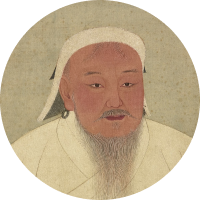

The Uyghur alphabet became the official script of Mongolia after Genghis Khan recruited a Uyghur scholar to instruct his sons.Chinese characters were widely used during the period, but Genghis Khan adopted Uyghur characters as part of a comprehensive strategy to prevent Chinese culture from assimilating Mongolian culture. The Great Government Law he published is thought to have been the first constitution of Central Asia as well as Great Mongolia at the time. The major idea of the Great Government Law was centered on matters like respecting seniors, caring for children, keeping the peace, observing the law, and firmly adhering to the duties assigned by the Emperor. Other important concepts were honoring the king or the state and allegiance to the king or the state.
Genghis Khan was a very smart ruler who strengthened the positive aspects of the land he had conquered while eliminating the negative ones. The State Stamp was created in 1206 by Tatatunga Daalgan, a captive seal officer from Naiman province. He invited eminent scholars from other nations, with whom he held discussions on a range of subjects. For instance, he could meet an ancient monk named Chang Chun Bumbo after courting him many times. That's how Genghis Khan was able to make all of his decisions and give instructions for how to run the country after his death eight or nine years before his passing.
Genghis Khan was born in 1162 in a place called Delung Boldog near the Onon River in Khentii Province.He founded Great Mongolia at the age of 44, and died in 1227 at the age of 65. When Genghis Khan died, he was buried in the soil of his homeland and his resting place covered hundreds of kilometers of land which was then made a sacred place. For 800 years, this place was guarded by warrior clans and closed to none but the Golden Clans and it was labeled as the Great Barrier. Hunting, cutting trees, moving stones, making trails, building houses and temples, traveling, and building roads and bridges were all forbidden in that area.
The Great Barrier was renamed "sanctuary" in the middle of the 20th century when a Soviet military outpost was constructed nearby. Since then, herdsmen have settled on the outskirts, hunters and tourists have begun to come, and people have been searching for Genghis Khan's tomb.


Ogedei Khan (1186-1241)

When the Khorezm Empire was overthrown in 1225, Genghis Khan brought his sons to the head of the Erchis River and distributed the acquired regions among his four sons. Zuchi received Turkestan, Tsagaadai Maverennakhr, Ogedei Seven Rivers and Dzhungar, and Tului Mongolia.
Following Genghis Khan's return from Khorezm, he called the great assembly to decide who should be seated on the throne. Tsagadai objected and insulted Zuch because Zuch was given the opportunity to speak first during the assembly, which sparked Tsagadai's outrage. When Genghis Khan expressed his concern and scolded them, they agreed to choose Ogedei as the successor.
Ogedei, the third son of Genghis Khan, lived from 1186 to 1241. Ogedei joined Genghis Khan on his invasion of the Golden State in 1211, marking the beginning of his military career. He invaded Urgench during the Khorezm War alongside Zuchi, Tsagadai, and Boorchi, vanquished their descendant Jelal Ad Din on the banks of the Indus River in 1221, and took part in the capture of Tangud in 1225. Tului oversaw state affairs for two years following the passing of Genghis Khan in 1227. Ogedei was assigned to the great seat in accordance with the king's wishes when the Great Assembly was called in 1229. At the discussion, it was decided to fully destroy the Golden State of Zurchids, attack Kore, where the Mongolian ambassador was killed, wipe out the last of Khorezm, tame the Kipchaks, and settle the situation on the western border.
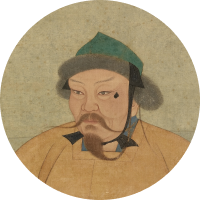

During his 13-year reign, Ogedei Khan had the laws discussed in the Great Assembly, improved the organization of the state, expanded the state relay stations, issued a tax law, and continued his war to the east taking control of the Golden State and subduing Kore, or modern-day Korea, in 1234.
Kharkhorum, the nation's capital, was also greatly extended. The royal palace was constructed, and wells were extensively excavated and constructed in 1235. The metallurgical industry expanded and several combat weapons were made during Ogedei Khan's rule.
In 1235, an order was issued and Bata, the son of his eldest brother Zuchi, was entrusted with the campaign to the west. The war of territorial expansion that began under the order of Ogedei Khan was a great war in the history of Mongols that covered vast areas of Asia and Europe. The Mongols were the first nation to fight a war on two different fronts at the same time, and to win on both.


Güyük Khan (1206-1248)

In 1206, Guyug Khan was born to Durgane, the sixth queen of Ogedei Khan (there are many records where she was marked as Queen Turakina). In 1241, when Ogedei Khan ascended to heaven, Guyug was fighting in the west, and in 1245, Queen Durgane, his mother, sent messengers to all sides and convened the Great Assembly, and crowned Guyug as the king of the Mongolian Empire.
Plano Carpini, a state representative for the Holy Roman Empire, made his first visit to Mongolia on February 23, 1246, and handed to King Guyug the letter from the Pope. It was asked in the letter that the Mongols adhere to their religion. This plainly incensed King Guyug, who responded, "But you have to come here and offer everything you have. Otherwise, not only do we know what will happen, but also the eternal blue sky."
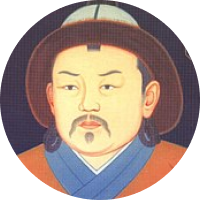

Upon his return following a long journey, messenger Plano Carpini told the Christians for the first time about the country known as Mongolia. As the first precise and thorough depictions of Asia at the time, Plano Carpini's notebooks quickly rose to the status of one of the Mongols' most valuable sources. “All of the nations in the world—aside from us—have been subjugated by Mongolia, and they are currently very close to coming here and attacking us”, he declared.
A letter sent from King Guyug to Pope Innocent IV is now in the secret archives of the Vatican, and a copy is kept in the National Museum of Mongolia. He sent the letter on November 3, 1246 and ordered Pope Innocent IV to submit to the Mongol Empire. The seal printed on the letter evokes the image of the seal of Great Mongolia made by Genghis Khan's official Tatatunga, and the inscription reads: "If, under the power of the Eternal Heaven, the decree of Dalai Khan of the Great Mongolian State reaches a citizen, treat it with respect and dread". The letter is regarded as the earliest representation of diplomatic contacts between Mongolia and other countries. In the vicinity of Samarkand, Guyug Khan passed away in 1248.


Möngke Khan (1209-1259)

He was born in 1208, the year of the golden dragon, to Queen Sorhagtani Behi of Tulu. While the infant was still in the cradle, shaman Tev went to Tului's house and spent the entire day doing shamanic rituals. "This kid will one day be as respected as the eternal sky. Call him Möngke (Eternal)", he said. The young boy had always been interested in geometry and mathematics. He was fluent in four or five other languages. Möngke was the first Mongolian scholar to study geometry and numerology, according to historical records.
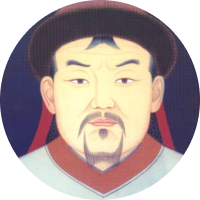

Soon after he was crowned as the great Mongolian ruler on Khudeo Island in 1251, he made reforms in the tax system. One animal was taxed for every 100 animals and up to 100 animals were exempt from taxation. A special focus was placed on raising the number of livestock, irrigating the Gobi region, settling the population, safeguarding the grasslands, and bringing superior breeds of livestock from the occupied countries to enhance and breed animals. It was particularly important to keep an eye on the quantity of horses. Möngke Khan followed a strategy of supporting numerous religious sects, and the relay station system which was initiated by Ogedei Khan was further developed and regulated. He built a silver tree in Kharkhorum that exudes four different types of liquids, attracting visitors from far and near.
Typhoid fever epidemics occurred in 1259, and Möngke Khan passed away as a result of the disease soon after. It is said that his remains were buried in Mount Burhan Khaldun along with the remains of Genghis Khan and Tului.


Kublai Khan (1215-1294)

He is regarded as a world-class king for having ruled not only the Mongolian Yuan Dynasty, which conquered the East, but also the Golden Palace State and the Chagaadain State, which existed in Asia and Europe. Kublai Khan occupies a much higher position than any other statesmen in Mongolia. It can also be considered that he laid the foundation for the establishment of today's unified great China. He is a meritorious person who opened the world trade route by ensuring the safety of the Silk Road connecting the East and the West.
The first paper money with legal backing was issued by Kublai Khan. The enormous continent of Eurasia accepted the paper money. At that time, the paper money issued by Kublai Khan was equivalent to today's US dollar.
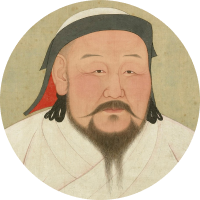

A naval fleet was also organized for the first time in the world, laying the groundwork for the growth of maritime transport. He built a large navy and attacked Japan. Small countries in the Pacific Islands, namely Indonesia were invaded and taken under his control. He oversaw this vast empire by staying at the border between the ancient Chinese settlers and the ancient nomads who brought the countries of the world to a new stage of development by bringing them into a single network called East and West.
Marco Polo, a renowned explorer, quoted Khubilai Khan as having said: "He was neither short nor tall, a decent, and extremely smart person. But he enjoyed drinking in his later years. He was very level-headed, far-sighted, and generally a very calm individual". Mongol kings had four official queens, and so did Kublai Khan. Concubines also existed, and if a male child was born to them, they were elevated to the position of step-queen. Kublai Khan is said to have had 25 sons, all of whom served as provincial and city governors.

